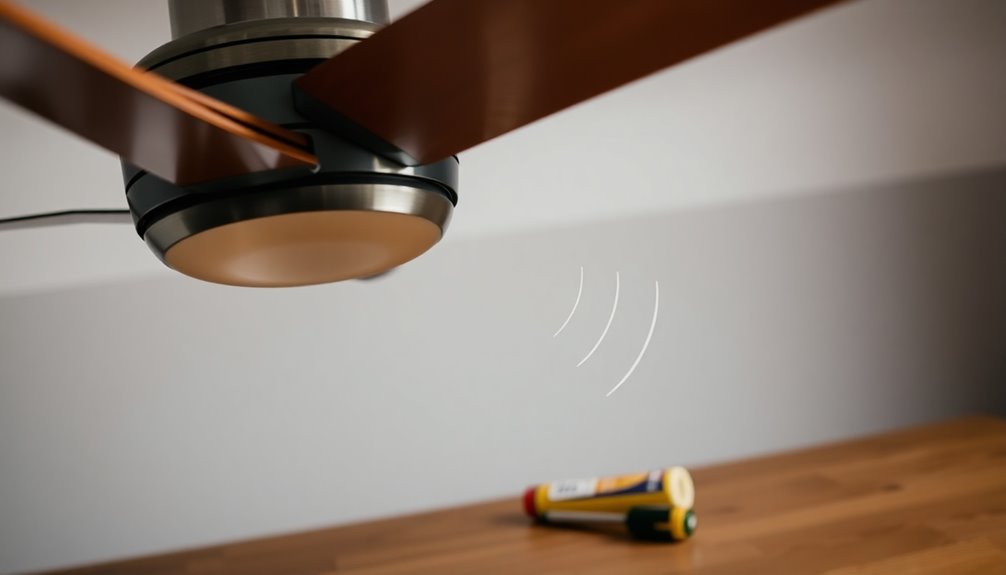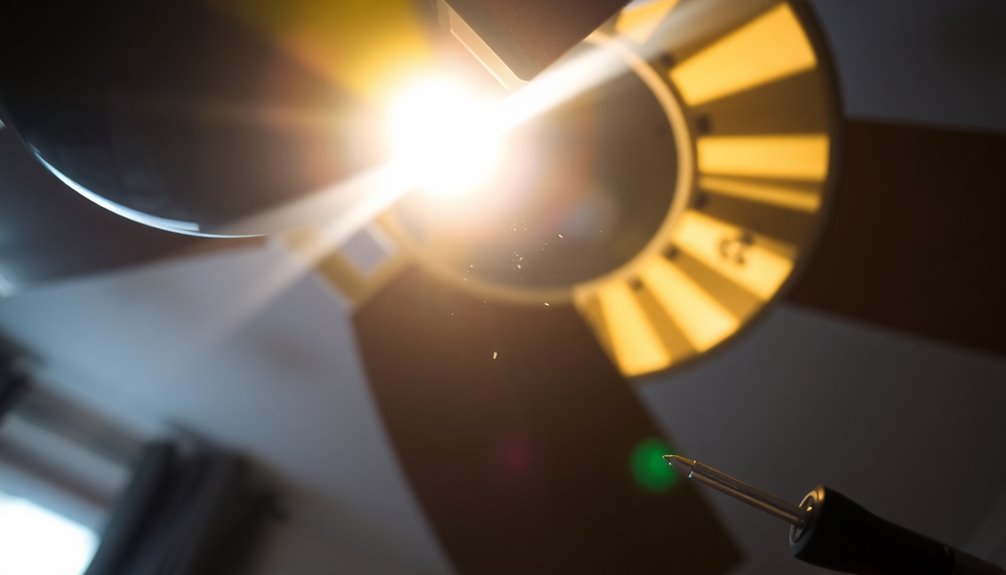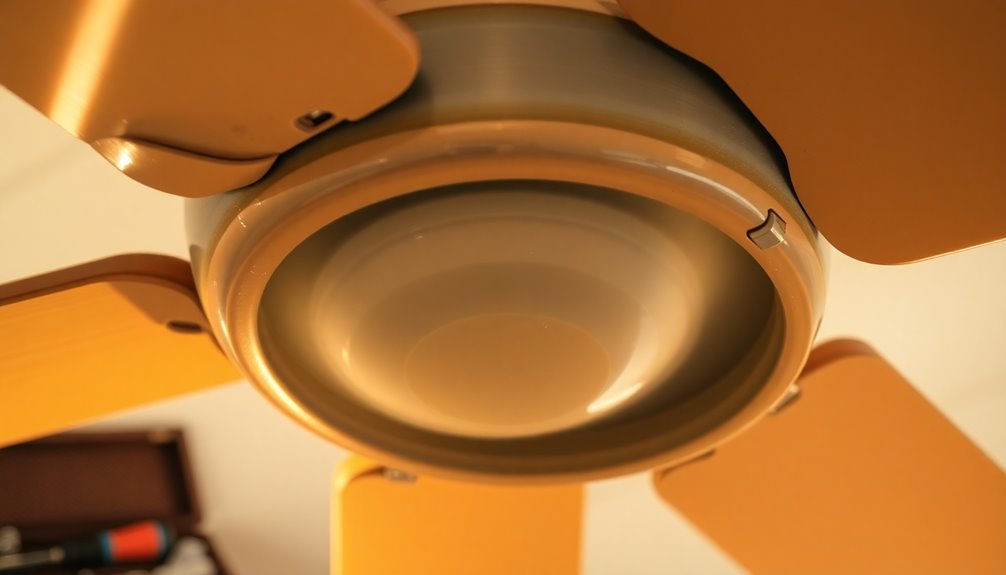If your ceiling fan hums, it might indicate electrical issues with the motor or wiring. Loose wiring connections can create resistance, leading to that annoying sound. Another common cause is insufficient lubrication in the motor, which increases friction. Sometimes, using incompatible light bulbs can also contribute to the hum. To troubleshoot, check and tighten all wiring and screws, lubricate the motor annually, and verify your bulbs are compatible. Regular maintenance is essential in minimizing noise and enhancing performance. Stay tuned to uncover more effective tips to keep your fan humming smoothly without the unwanted noise.
Key Takeaways
- Humming often indicates loose wiring connections, which can create electrical resistance and cause noise.
- Insufficient lubrication of the motor can lead to increased friction, resulting in humming sounds.
- Using incompatible light bulbs can raise the electrical load, leading to humming at different speeds.
- Dimmer switches may cause voltage fluctuations, contributing to humming noise at lower fan speeds.
- Regular maintenance, including inspecting wiring and lubricating the motor, can help minimize humming noises.
Understanding Ceiling Fan Noises

Ceiling fan noises can be puzzling, but understanding them is key to keeping your fan running smoothly. When you hear a ceiling fan noise, particularly humming, it often points to electrical issues related to the motor or wiring.
Loose parts can worsen these sounds, as vibrations cause components to rattle. If your fan's humming intensifies at lower speeds, a dimmer switch might be the culprit, causing voltage fluctuations.
Regular maintenance is crucial; lubricating the motor and checking wiring can minimize humming and guarantee peak operation. Proper maintenance is essential for preventing dangerous situations that may arise from neglecting your ceiling fan.
Identifying the noise's type, like buzzing or humming, directs your troubleshooting efforts toward specific motor issues or mechanical problems, making it easier to resolve any disturbances effectively.
Common Causes of Humming

If your ceiling fan is humming, it might be due to loose wiring connections, insufficient motor lubrication, or even incompatible light bulbs.
These issues can't only create annoying noises but also affect the fan's performance.
Let's explore these common causes to help you pinpoint the problem.
Loose Wiring Connections
When your ceiling fan starts humming, one common culprit might be loose wiring connections. These connections can create electrical resistance, leading to an uneven power flow that causes that annoying humming noise.
Over time, vibrations from fan operation can loosen wires, worsening the issue. Here are some key points to contemplate:
- Inspect wire connections in the junction box for tightness.
- Remove excess slack in the wiring to reduce vibrations.
- Regular maintenance checks on wiring connections can prevent problems.
- Ascertain no wires are touching, as this might amplify the noise.
Insufficient Motor Lubrication
A humming ceiling fan can often signal insufficient motor lubrication, which causes friction between its moving parts.
When the motor's bearings dry out or get dirty, they can create that pesky humming noise you hear. Regular maintenance is essential—lubricating the motor at least once a year helps prevent this issue.
A well-lubricated motor operates smoothly, reducing friction and minimizing noise. Without adequate lubrication, you might also notice overheating and decreased efficiency from your fan.
To keep your ceiling fan running quietly and efficiently, make it a habit to check and maintain the motor. This simple act of lubrication can save you from more significant problems down the road.
Incompatible Light Bulbs
Sometimes, incompatible light bulbs can be the culprit behind that annoying humming noise in your ceiling fan.
Using the wrong type or wattage of bulbs can increase the electrical load on the fan's motor, leading to that irritating sound.
Here are some common issues to look out for:
- Higher wattage bulbs exceeding the fan's recommendations
- Dimmable LED bulbs with non-dimmable switches
- CFL and LED bulbs not designed for ceiling fans
- Low-quality bulbs lacking necessary components
To minimize humming, verify all light bulbs are compatible in wattage and type.
It's also a good idea to stick with standard ON/OFF switches instead of dimmer switches.
Identifying Clicking Noises

You might notice clicking noises coming from your ceiling fan, and identifying the cause is vital for a smooth operation.
Often, these sounds stem from loose blades or blade holder screws that create vibrations when the fan operates. Start by tightening the screws on the blade holders, as this can eliminate persistent clicking noises.
After tightening, inspect the blade holders to verify everything is secure. If the clicking persists, you may need to check for damaged blades or misaligned blade arms.
Turning off the fan and testing it with the blades removed can help isolate the source of the noise.
Always consult your owner's manual for specific instructions on maintenance to prevent future issues.
Troubleshooting Rubbing Sounds

When ceiling fans produce rubbing sounds, it often indicates issues with the installation or alignment of the blade holders.
To troubleshoot the problem, follow these steps:
- Confirm the fan is correctly installed according to the owner's manual.
- Inspect blades for warping or damage, as misaligned blades can create a rubbing noise.
- Check for any loose blades or components that may need tightening.
- Perform regular maintenance, including cleaning dust and debris from the blades.
Addressing Crackling or Sizzling

Hearing crackling or sizzling noises from your ceiling fan can be alarming, as these sounds often signal serious electrical issues that need immediate attention.
First, turn off the power to prevent potential electrical hazards. This noise typically indicates loose wire connections or damaged components, which pose a fire risk.
If you notice a popcorn-like odor alongside the crackling or sizzling sounds, it's vital to act quickly and seek a professional inspection.
Remember, safety precautions are fundamental—avoid attempting repairs on electrical components unless you're qualified.
Instead, consult customer service or a certified electrician to troubleshoot and resolve any identified issues safely.
Prioritizing your safety will help guarantee your ceiling fan operates properly without further risks.
Fixing Buzzing and Humming

If your ceiling fan is producing a persistent buzzing or humming noise, it's crucial to address the issue promptly to guarantee safe and efficient operation.
Start by inspecting the fan for common causes:
- Check for loose wires or bad connections.
- Test the fan at different speeds to identify patterns.
- Inspect the fan motor capacitor for burn marks or loose connections.
- Consider if a dimmer switch is causing voltage changes.
If you find any issues, regular maintenance like tightening screws and lubricating the motor can help prevent future humming or buzzing. Additionally, ensuring that the fan's filters are clean can improve overall performance and reduce noise.
If problems persist, don't hesitate to seek professional assistance to verify your fan motor's safety and performance.
Importance of Proper Installation

Proper installation of your ceiling fan is essential for minimizing noise issues.
When you secure the mounting brackets and guarantee consistent blade height, you set the stage for a smooth and quiet operation.
Neglecting these steps can lead to unwanted vibrations and humming that disrupt your comfort.
Secure Mounting Brackets
When you install a ceiling fan, securing the mounting brackets is crucial to minimize vibrations and assure smooth operation.
Loose brackets can lead to increased noise and affect fan speed, making proper installation essential.
To guarantee your brackets are secure, follow these tips:
- Use the correct hardware for your ceiling type.
- Regularly check the tightness of the brackets.
- Avoid incompatible mounting systems that can cause wobbling.
- Secure a snug fit to reduce wear and tear.
Additionally, ensuring the brackets are securely mounted can help maintain optimal image quality for any lighting in the room, enhancing the overall ambiance.
Blade Height Consistency
Ensuring blade height consistency is essential for the smooth operation of your ceiling fan, as uneven blades can lead to vibrations and unwanted noise.
When blades are misaligned, it can cause them to brush against the motor housing or other components, resulting in mechanical noise that disrupts your peace. Proper installation means verifying that all blades are mounted at the same height, which prevents wobbling and reduces the risk of vibrations and increased noise.
Regularly inspecting blade height during maintenance checks can help catch alignment issues before they escalate. Additionally, ensuring compatibility of the fan's mounting system with your ceiling type plays a vital role in optimizing performance and minimizing unwanted sounds. Furthermore, maintaining a clean environment helps to improve air quality, which can also contribute to quieter fan operation.
Regular Maintenance Practices

To keep your ceiling fan running quietly and efficiently, regular maintenance is crucial. By following these simple practices, you can minimize humming and guarantee smooth operation:
- Inspect all screws and components regularly to tighten them and reduce vibrations.
- Clean the fan blades and motor housing every few months to prevent dust buildup, which can increase noise levels.
- Lubricate the bearings annually to maintain smooth operation and reduce friction sounds.
- Use a blade balancing kit periodically to check and adjust the balance of the blades, preventing wobbling.
Tools Needed for Troubleshooting

When troubleshooting your ceiling fan's humming noise, you'll need a few essential tools to get started.
A screwdriver set, wrench, and lubricant are key for tightening components and reducing friction.
Don't forget a cleaning cloth and a level to guarantee everything runs smoothly and is properly balanced.
Essential Tools Overview
Troubleshooting a humming ceiling fan requires a few essential tools to tackle the issue effectively. Having the right equipment on hand will make your job easier and more efficient.
Here's what you'll need:
- Screwdriver set: Tighten any screws and fittings that may have loosened over time.
- Wrench: Adjust loose components to guarantee all parts are securely mounted.
- Lubricant: Maintain smooth operation of the motor and bearings, reducing friction and humming sounds.
- Cleaning cloth: Remove dust and debris from blades and motor housing to minimize operational noise.
Additionally, using a level helps check blade balance, preventing wobbling that can lead to more noise. Regular maintenance of your ceiling fan can also help prevent humming issues in the future.
With these tools, you'll be well-prepared to address your ceiling fan's humming issue.
Maintenance Equipment Checklist
A well-rounded maintenance equipment checklist is essential for effectively addressing humming noises in your ceiling fan.
First, grab a screwdriver set to tighten any loose screws and fittings, which can help eliminate vibrations.
Next, use a level to check the blade balance; unbalanced blades often lead to annoying humming sounds.
You'll also need lubricant to maintain the bearings, as proper lubrication reduces friction and noise from the motor.
Don't forget a cleaning cloth to wipe away dust and debris from the fan blades and motor, preventing additional operational noise.
Ultimately, keep a wrench handy for adjusting any loose components that might be causing those irritating vibrations and humming sounds.
With these tools, you'll be well-equipped to troubleshoot your ceiling fan.
When to Seek Professional Help

If humming noises persist despite your best efforts to fix them, it's time to contemplate calling in a professional. Ignoring these issues could lead to bigger problems down the line.
Here are some signs that you should consult a professional electrician:
- You're noticing signs of electrical faults, like sparking or burning smells.
- The fan shows signs of structural damage or instability after repairs.
- You're facing complex wiring problems that go beyond basic DIY fixes.
- You lack confidence in troubleshooting and want to guarantee safety.
Addressing these concerns promptly can prevent hazards and guarantee your ceiling fan operates safely.
Don't hesitate to reach out to a professional for peace of mind and effective resolution.
Frequently Asked Questions
How to Fix Ceiling Fan Humming Noise?
To fix your ceiling fan's humming noise, start by checking the motor and capacitor for loose connections or damage.
Tighten any loose screws and fittings, as they can vibrate and amplify the sound.
Test the fan at various speeds to see if the humming changes.
If you're using a dimmer switch, consider switching it to a standard ON/OFF switch.
Finally, clean the fan regularly to prevent dust buildup that can cause noise.
How Do I Get My Ceiling Fan to Stop Making Noise?
If you want your ceiling fan to stop making noise, start by inspecting and tightening all screws and fittings.
Check that the motor's properly lubricated, as lack of lubrication can cause friction.
Look for compatibility issues with dimmer switches, and consider switching to standard ON/OFF models.
Don't forget to clean the blades and motor housing regularly, as dust buildup can worsen the noise and affect performance.
Why Is My Cooling Fan Making a Humming Sound?
When it comes to your cooling fan making a humming sound, it's often a case of something being amiss.
You might find loose wires or a lack of lubrication causing friction. If you've got a dimmer switch, it could be messing with the voltage too.
Try different speeds to see if the noise changes. If you can't pinpoint the issue, don't hesitate to call a licensed electrician to get to the bottom of it.
Will a Bad Capacitor Make a Ceiling Fan Hum?
Yes, a bad capacitor can definitely make your ceiling fan hum.
When the capacitor struggles to regulate the electrical flow, it creates an abnormal operation that often results in those annoying humming noises.
You might notice this sound more at lower speeds or if the fan has trouble starting.
It's a good idea to inspect the capacitor for any visible damage or loose connections and replace it if necessary.
Conclusion
In the world of ceiling fans, a humming noise can be a pesky reminder that something's amiss. By understanding the common causes and troubleshooting effectively, you can restore peace and quiet to your space. Just like a well-tuned orchestra, your fan deserves attention for peak performance. Remember, regular maintenance is key to avoiding future issues. If the noise persists despite your efforts, don't hesitate to call a professional—they'll help you tune out the distractions for good.









